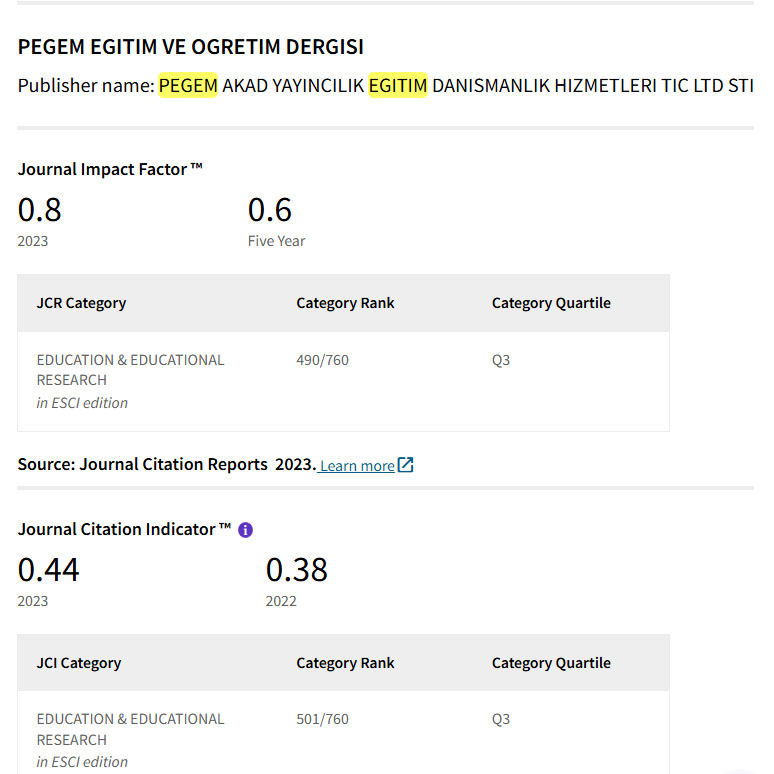Effectiveness of code-switching in language classroom in India at primary level: A case of L2 teachers’ perspectives
DOI:
https://doi.org/10.47750/pegegog.11.04.37Keywords:
Bilingualism, code-switching, first language (L1), language classroom, second language (L2) learnersAbstract
The current study explores the effectiveness of code-switching (CS) in language classroom, a case of second language (L2) teachers’ perspectives. Code-switching (CS) refers to a usage of the two languages in conversation and it also relates to a ‘language mixing’. CS may occur between sentences, known as 'inter-sentential code-switching’; and it may also occur within a sentence, known as 'intra-sentential code-switching’. Code-switching is a linguistic feature of multi-lingual societies, as they are gifted with more privileges to use various languages. The current study points out the perceptions of language teachers towards code-switching in the classroom in the process of teaching and the purposes of code-switching in teaching. The data for the study includes the responses of the attitudinal test questions designed on a Likert Scale of 20 teacher- respondents from the two schools of Delhi-NCR. The outcome of the study illustrates that the predominance of code-switching in the classrooms is used to interpret complex ideas, translate questions, seek confirmation, check students understanding, also to build solidarity and code-switching is most prevalent in primary education. Hence, code-switching is a distinctive linguistic requirement in education but there is a negative towards the use of CS in the classroom.
Downloads
References
Ajmal, M., & Kumar, T. (2020). Using DIALANG in assessing foreign language proficiency: The interface between learning and assessment. Asian ESP Journal. 16 (2.2), 335 - 362.
Benyo, A. & Kumar, T. (2020). An analysis of Indian EFL learners’ listening comprehension errors. Asian ESP Journal. 16(5.2), 69-85.
Boztepe, E. (2003). Issues in code-switching: competing theories and models. Studies in Applied Linguistics and TESOL, 3(2).
Dendup, P. (2020). Code-Switching in the Classroom: The Perspectives of Bhutanese Teachers. International Journal of Linguistics and Translation Studies, 1(3), 47-57.
Garrett, P. (2010). Attitudes to Language. Cambridge University Press.
Goodman, D. (2006). Language Study in Teacher Education: Exploring the Language in Language Arts. Language Arts, 84(2), 145-156.
Gulzar, M. A. (2010). Code-switching: Awareness about its utility in bilingual classrooms. Bulletin of Education and Research, 32(2), 23-44.
Hakuta, K. (1986). Mirror of language. The debate on bilingualism. Basic Books, Inc., 10 East 53rd Street, New York, NY 10022.
Kumar, T. (2020a). Assessing language need and proficiency of English graduates of Prince Sattam Bin Abdulaziz University for designing pre-placement training and workshops. Asian ErtyreedeefbnvcSP Journal. 16(4), 153-168.
Kumar, T. (2020 b). Impact of motivation and group cohesion in EFL classrooms at Prince Sattam Bin Abdulaziz University, KSA. Asian EFL Journal. 27(4.4), 116-131.
Kumar, T. (2021). ‘Desire to learn, learn to shine’: Idolizing motivation in enhancing speaking skill among L2 learners. Cypriot Journal of Educational Science. 16(1), 411-422. https://doi.org/10.18844/cjes.v16i1.5542
Nesamalar, Saratha & Teh (1995). Code Switching in the Teaching of English as a Second Language to Secondary School Students. Malaysian Journal of ELT Research ISSN: 1511-8002 Vol. 6.
Nesamalar, et al. (1995). Code switching in the teaching of English as a second language to secondary school students. Malaysian Journal of ELT Research. Vol. 6.
Ovando, Collier and Combs (2003). Code Switching in the Teaching of English as a Second Language to Secondary School Students. Malaysian Journal of ELT Research , Vol. 6.
Poplack, S. (2001). Code-switching (linguistic). International encyclopaedia of the social and behavioral sciences, 12, 2062-2065.
Ryan, E. B., & Giles, H. (Eds.) (1982). Attitudes towards Language Variation: Social and Applied Contexts (pp. 1-19). London: Edward Arnold.
Shartiely, N. E. (2013). Discourse strategies of lecturers in higher education classroom interaction: a case at the University Dar Es Salaam, Tanzania (Doctoral dissertation, Stellenbosch: Stellenbosch University).
Taha, T. A. (2008). Language alternation in university classrooms. Journal of Instructional Psychology, 35(4), 336-346.
Wheeler, R. S., & Swords, R. (2010). Code-switching lessons: Grammar strategies for linguistically diverse writers: Grades 3-6. Firsthand Heinemann.
Willis (1996). Code Switching in the Teaching of English as a Second Language to Secondary School Students. Malaysian Journal of ELT Research ISSN: 1511-8002, Vol. 6.
Downloads
Published
How to Cite
Issue
Section
License
Copyright (c) 2021 Pegem Journal of Education and Instruction

This work is licensed under a Creative Commons Attribution-NonCommercial 4.0 International License.
Attribution — You must give appropriate credit, provide a link to the license, and indicate if changes were made. You may do so in any reasonable manner, but not in any way that suggests the licensor endorses you or your use.
NonCommercial — You may not use the material for commercial purposes.
No additional restrictions — You may not apply legal terms or technological measures that legally restrict others from doing anything the license permits.




